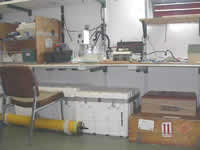| |
| |

The wet lab is battened-down and ready
for the frequent rolls and
pitches associated with the oceans motions.

Dr. Baker and Marine Technician
Support Assistant Daryl Swensen
discuss the science operations for the day.
|
|
Teacher Logbook - R/V Wecoma
Missy
Holzer 's Sealog:
CTD Cruise Day 15
Weather at 1630 hours PDT:
Cloudy skies with winds of 15 knots from the
northwest, and visibility of 12 miles. Barometric pressure is 1025.0 mb,
and the temperature is 60 degrees Fahrenheit. Ocean swells are 8 feet
out
of the northwest, and the seas are 5 feet out of the northwest.
The NeMO
CTD Cruise is currently at the Blanco Fracture Zone, which is its final
location along the Juan de Fuca Ridge. Since the water depth is greater
than 4500 meters at this location, we'll be deploying CTD casts, but no
tow-yo's. Tow-yo's at that depth tend to take a long period of time due
to the fact that the fish is lowered and raised in the water column a
number of times. The Blanco Fracture Zone is an area in the seafloor where
the Pacific plate and the Juan deFuca plate are sliding past one another,
and are pulling apart slightly too. Helium measurements made here at Blanco
over the past years have shown that there is some hydrothermal activity
worth sampling, and these samples will help to determine the extent of
such activity along the entire ridge system. The success of acquiring
these measurements as well as all the other measurements while on R/V
Wecoma not only depends on the knowledge of the science staff, but depends
on the skill and expertise of the crew on board, and especially Marine
Technician Support Assistant Daryl Swensen.
Acting as
a liaison between the ship's crew and the science staff,
the Mar-Tech (as Mr. Swensen is sometimes called) is knowledgeable in
the
workings of almost all areas of the ship as well as in the workings of
the
science instrumentation. Mr. Swensen brings to his job an extremely
varied background that allows him the versatility he needs in order to
be
successful in his job. His degree in Environmental Science provided him
with diverse knowledge base, but it was his work experience as a
commercial fisherman, construction worker, and as well as growing up on
a
farm that provided him with the diverse skills needed for ship work.
After completing a 1 year contract position as a bio technician for the
National Marine Fisheries in San Diego, Mr. Swensen came to Oregon State
University and R/V Wecoma in 1998.
While on a cruise on the R/V Wecoma, he takes charge of the shared-use
science equipment that's maintained by the R/V Wecoma, but used by the
visiting science staff. Today, most of research oceanography is done with
electronic instrumentation that allows data to be downloaded while on<
board so long as all the systems are compatible and can communicate with
each other. Mr. Swensen has the position of making sure that all systems
are "go", electronically speaking. This part of his position
requires him
to continue his education in computer programming, and in learning new
software programs. All the crewmembers have a knowledge base that goes
beyond their job titles, and on a ship the size of the R/V Wecoma everyone
helps out when they are needed and where they are needed. Mr. Swensen
can
be found in the engine room, on the deck, or in the labs sharing his vast
knowledge in order to help in troubleshooting in problem situations.
During the NeMO CTD Cruise, his untiring expertise was called upon during
various parts of the day and night in order for the science staff to
continually acquire data throughout the cruise.
Being a part
of the crew on a research vessel such as the R/V Wecoma has many rewards
that Mr. Swensen enjoys. They include the ability to travel in places
such as Australia, Hawaii, and Alaska, and to exist in a setting that's
moving at a pace different from the pace on land. His job as the Marine
Technician Support Assistant has offered him some diverse experiences
working with the visiting scientists. Besides working with the science
team on the NOAA-PMEL Vents Program, he has worked with marine biologists
studying copepods and other sea creatures, he's had the opportunity to
work with the US Navy doing acoustic research in the ocean, etc.
The NeMO
CTD Cruise is very fortunate to have the talents of Mr. Swensen, along
with the rest of the R/V Wecoma crew to be supporting their research endeavors.
Mr. Swensen is a true asset in helping the R/V Wecoma be a top notch research
vessel.
|
|

